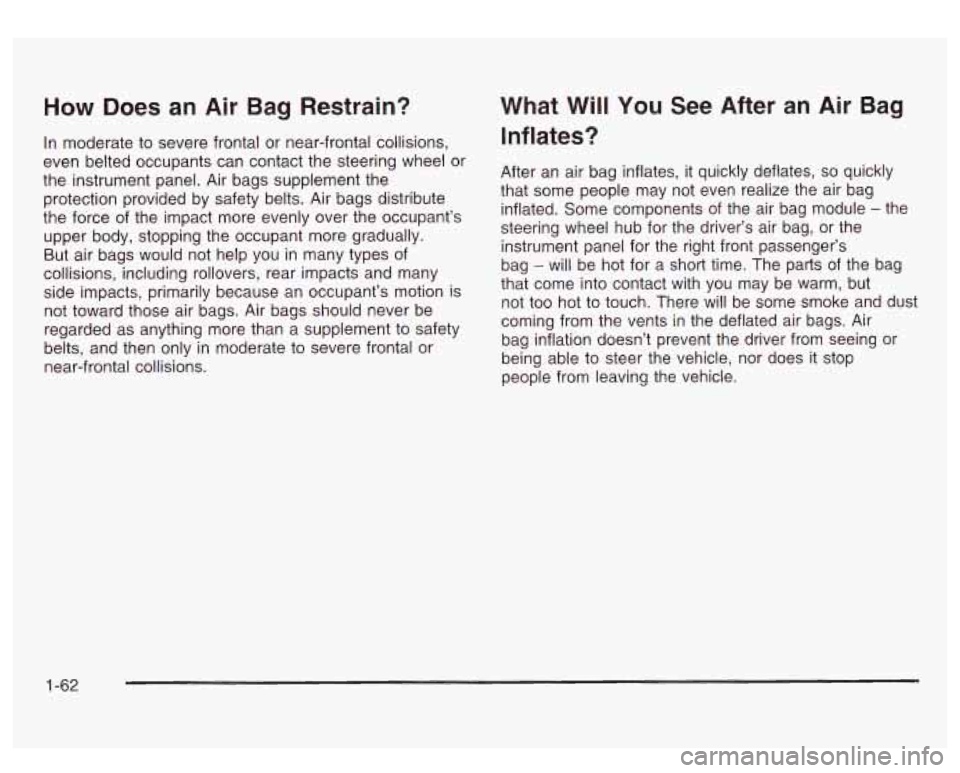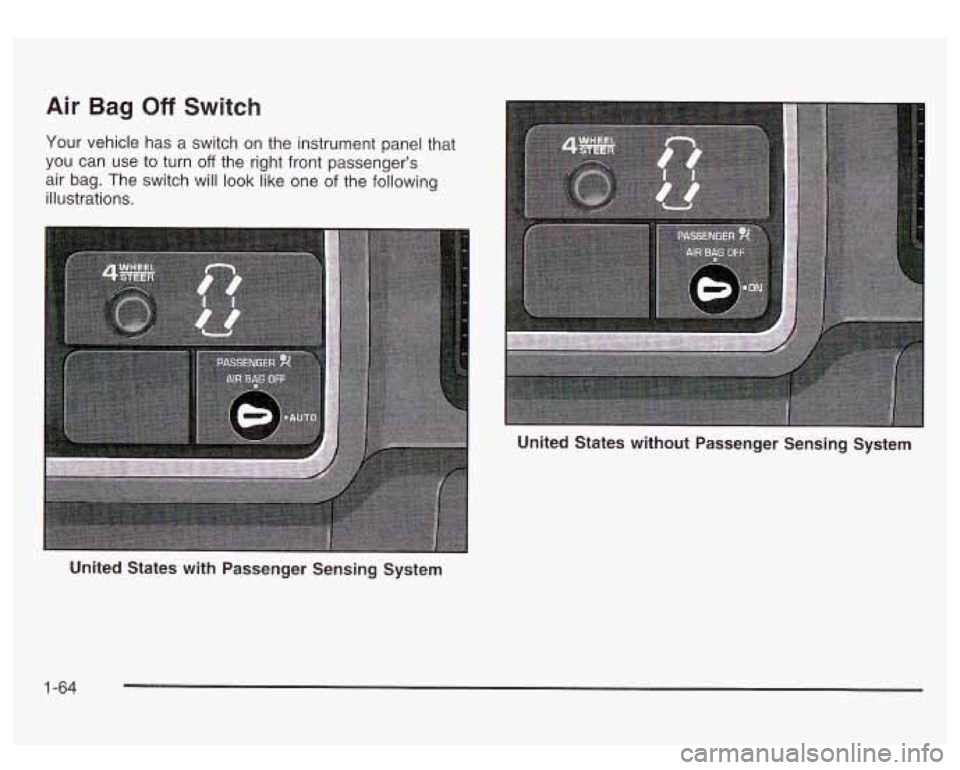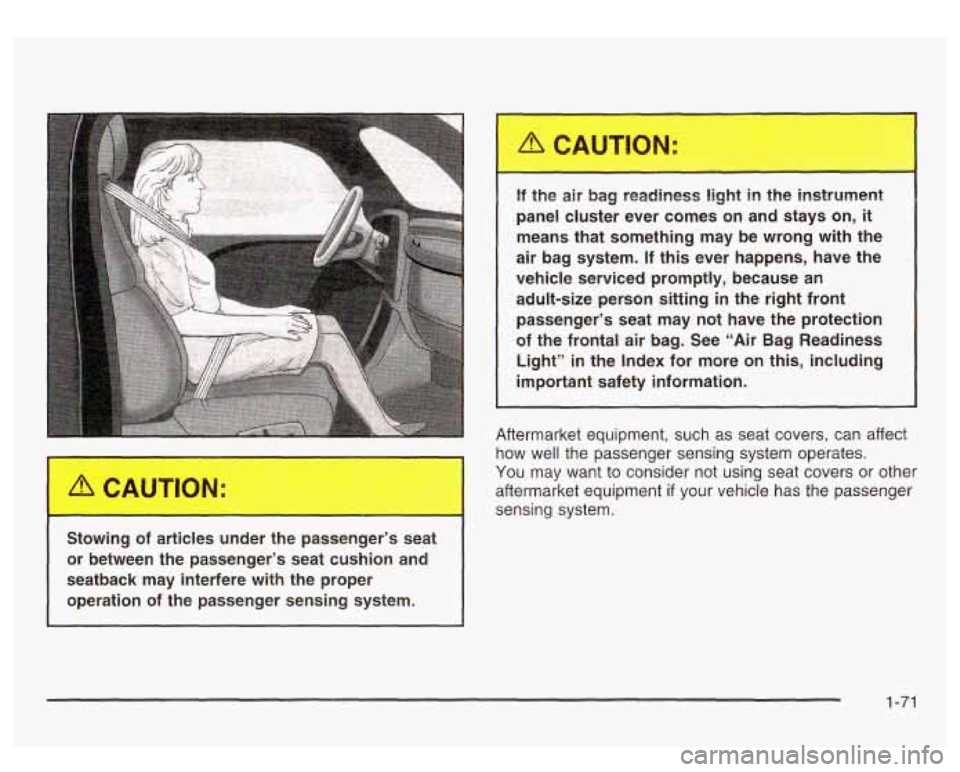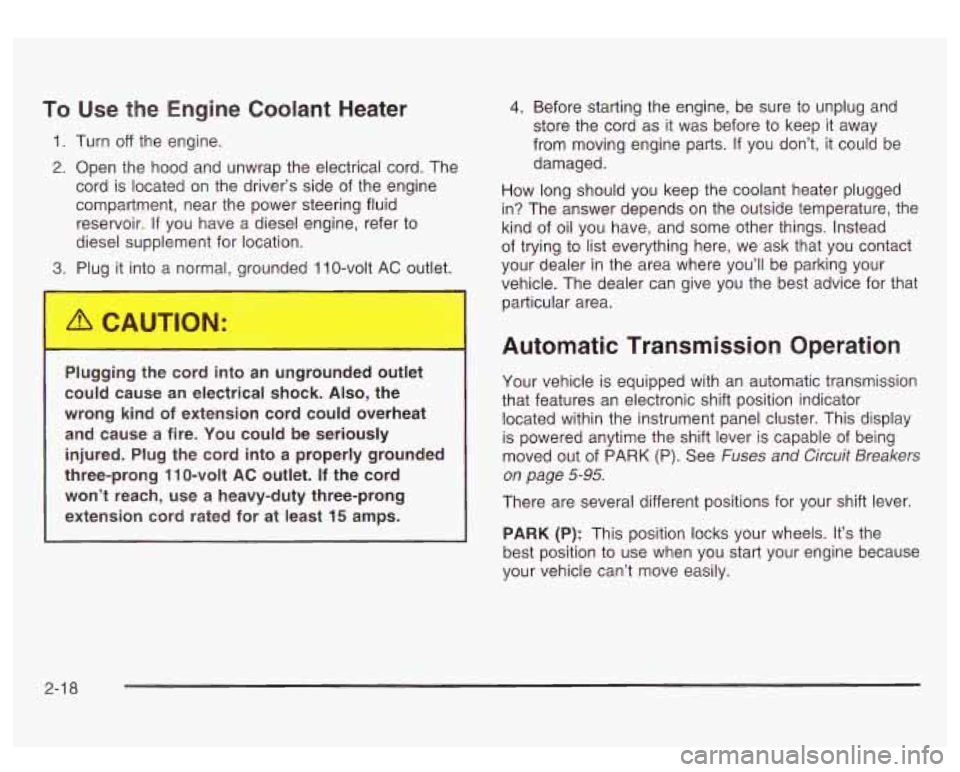2003 GMC SIERRA DENALI instrument panel
[x] Cancel search: instrument panelPage 68 of 428

When Should an Air Bag Inflate?
An air bag is designed to inflate in a moderate to severe
frontal, or near-frontal crash. The air bag will inflate
only
if the impact speed is above the system’s designed
“threshold level.”
In addition, your vehicle has “dual stage” frontal air
bags, which adjust the amount of restraint according to
crash severity. For moderate frontal impacts, these
air bags inflate at a level less than full deployment. For
more severe frontal impacts, full deployment occurs.
If the front of your vehicle goes straight into a wall that
doesn’t move or deform, the threshold level for the
reduced deployment is about
10 to 16 mph
(16 to 25 km/h), and the threshold level for a full
deployment is about
20 to 25 mph (32 to 40 km/h). The
threshold level can vary, however, with specific
vehicle design,
so that it can be somewhat above or
below this range.
If your vehicle strikes something that will move or
deform, such as a parked car, the threshold level will be
higher. The air bag is not designed to inflate in
rollovers, rear impacts, or in many side impacts because
inflation would not help the occupant.
In any particular crash, no one can say whether an air
bag should have inflated simply because of the damage
to a vehicle or because of what the repair costs were. Inflation
is determined by the angle of the impact and
how quickly the vehicle slows down in frontal or
near-frontal impacts.
The air bag system
is designed to work properly under
a wide range
of conditions, including off-road usage.
Observe safe driving speeds, especially on rough
terrain.
As always, wear your safety belt. See “Off-Road
Driving” in the Index for more tips on off-road driving.
Seat Position Sensors
Vehicle’s with dual stage air bags are also equipped
with special sensors which enable the sensing system to
monitor the position of both the driver and passenger
front seats. The seat position sensor provides
information which is used to determine
if the air bags
should deploy at a reduced level or at full depoyment.
What Makes an Air Bag Inflate?
In an impact of sufficient severity, the air bag sensing
system detects that the vehicle is in a crash. The
sensing system triggers a release of gas from the
inflator, which inflates the air bag. The inflator, air bag,
and related hardware are all part of the air bag
modules inside the steering wheel and in the instrument
panel in front of the right front passenger.
1-61
Page 69 of 428

How Does an Air Bag Restrain?
In moderate to severe frontal or near-frontal collisions,
even belted occupants can contact the steering wheel or
the instrument panel. Air bags supplement the
protection provided by safety belts. Air bags distribute
the force of the impact more evenly over the occupant’s
upper body, stopping the occupant more gradually.
But air bags would not help you in many types of
collisions, including rollovers, rear impacts and many
side impacts, primarily because an occupant’s motion is
not toward those air bags. Air bags should never be
regarded as anything more than a supplement to safety
belts, and then only in moderate to severe frontal or
near-frontal collisions.
What Will You See After an Air Bag
Inflates?
After an air bag inflates, it quickly deflates, so quickly
that some people may not even realize the air bag
inflated. Some components of the air bag module
- the
steering wheel hub for the driver’s air bag, or the
instrument panel for the right front passenger’s
bag
- will be hot for a short time. The parts of the bag
that come into contact with you may be warm, but
not too hot to touch. There will be some smoke and dust
coming from the vents in the deflated air bags. Air
bag inflation doesn’t prevent the driver from seeing or
being able to steer the vehicle, nor does it stop
people from leaving the vehicle.
1-62
Page 70 of 428

When an air bag inflates, there is dust in the
air. This dust could cause breathing problems
for people with
a history of asthma or other
breathing trouble.
To avoid this, everyone in
the vehicle should get out as soon as it is safe
to do
so. If you have breathing problems but
can’t get out of the vehicle after an air bag
inflates, then get fresh air by opening a
window or
a door. If you experience breathing
problems following an air bag deployment, you
should seek medical attention.
In many crashes severe enough to inflate the air bag,
windshields are broken by vehicle deformation.
Additional windshield breakage may also occur from the
right front passenger air bag.
Air bags are designed to inflate only once. After
they inflate, you’ll need some new parts for your
air bag system.
If you don’t get them, the air
bag system won’t be there to help protect you in
another crash.
A new system will include air
bag modules and possibly other parts. The service
manual for your vehicle covers the need to
replace other parts.
Your vehicle is equipped with electronic frontal
sensors which help the sensing system distinguish
between a moderate and a more severe frontal
impact. Your vehicle is also equipped with a crash
sensing and diagnostic module, which records
information about the frontal air bag system. The
module records information about the readiness of
the system and when the system commands
are bag inflation. It records the status of the driver’s
safety belt usage in a crash in which the air bag
deploys or a crash in which the air bag nearly
deploys. The module also records speed, engine
RPM, brake and throttle data.
Let only qualified technicians work on your air bag
systems. Improper service can mean that an air
bag system won’t work properly. See your dealer for
service.
Notice: If you damage the covering for the driver’s
or the right front passenger’s air bag, the bag
may not work properly.
You may have to replace the
air bag module in the steering wheel or both the
air bag module and the instrument panel for
the right front passenger’s air bag.
Do not open or
break the air bag coverings.
1-63
Page 71 of 428

Air Bag Off Switch
Your vehicle has a switch on the instrument panel that
you can use to turn
off the right front passenger’s
air bag. The switch will look like one of the following
illustrations.
United States with Passenger Sensing System United States without Passenger Sensing System
1-64
Page 76 of 428

Passenger Air Bag
Status
Indicator
- Canada
The passenger sensing system will turn
off the right
front passenger’s frontal air bag under certain
conditions. The driver’s air bag and the side air bags
are not part of the passenger sensing system. In
addition to the passenger sensing system, your vehicle
also has an air bag
off switch located on the instrument
panel as required by the government.
The passenger sensing system works with sensors that
are part of the right front passenger’s seat and safety
belt. The sensors are designed to detect the presence of
a properly seated occupant and determine
if the
passenger’s frontal air bag should be enabled (may
inflate) or not. The passenger
sensing system is designed to turn
oft
the right front passenger’s frontal air bag if:
the right front passenger seat is unoccupied
the system determines that an infant is present in a
rear-facing infant seat
J the system determines that a small child is present
in a forward-facing child restraint
the system determines that a small child is present
in a booster seat,
0 a right front passenger takes hidher weight off of
the seat for a period of time
the right front passenger seat is occupied by a
smaller person, such as a child who has outgrown
child restraints or a very small person
the air bag off switch is in the off position
or if there is a critical problem with the air bag
system or the passenger sensing system
When the passenger’s frontal air bag has been turned
off either by the passenger sensing system or by the air
bag
off switch, the off indicator will light and stay lit to
remind you that the air bag is
off.
1-69
Page 78 of 428

Aftermarket equipment, such as seat covers, can affect
how well the passenger sensing system operates.
You may want to consider not using seat covers or other
aftermarket equipment
if your vehicle has the passenger
sensing system.
Stowing of articles under the passenger’s seat or between the passenger’s seat cushion and
seatback may interfere with the proper operation of the passenger sensing system.
I I
If the air bag readiness light in the instrument
panel cluster ever comes on and stays on,
it
means that something may be wrong with the
air bag system. If
this ever happens, have the
vehicle serviced promptly, because an adult-size person sitting
in the right front
passenger’s seat may not have the protection
of the frontal air bag. See “Air Bag Readiness
Light”
in the Index for more on this, including
important safety information.
Page 99 of 428

To Use the Engine Coolant Heater
1. Turn off the engine.
2. Open the hood and unwrap the electrical cord. The
cord is located on the driver’s side of the engine
compartment, near the power steering fluid
reservoir. If you have a diesel engine, refer to
diesel supplement for location.
3. Plug it into a normal, grounded 11 0-volt AC outlet.
Plugging the cord into an ungrounded outlet
could cause an electrical shock. Also, the
wrong kind of extension cord could overheat
and cause a fire. You could
be seriously
injured. Plug the cord into a properly grounded
three-prong
11 0-volt AC outlet. If the cord
won’t reach, use a heavy-duty three-prong
extension cord rated for at least
15 amps.
4. Before starting the engine, be sure to unplug ana
store the cord as it was before to keep it away
from moving engine parts.
If you don’t, it could be
damaged.
How long should you keep the coolant heater plugged
in? The answer depends on the outside temperature, the
kind of oil you have, and some other things. Instead
of trying to list everything here, we ask that you contact
your dealer in the area where you’ll be parking your
vehicle. The dealer can give you the best advice for that
particular area.
Automatic Transmission Operation
Your vehicle is equipped with an automatic transmission
that features an electronic shift position indicator
located within the instrument panel cluster. This display
is powered anytime the shift lever
is capable of being
moved out
of PARK (P). See Fuses and Circuit Breakers
on page
5-95.
There are several different positions for your shift lever.
PARK
(P): This position locks your wheels. It’s the
best position to use when you start your engine because
your vehicle can’t move easily.
2-1 8
Page 102 of 428

Tow/HauI Mode
Your vehicle may be equipped with a tow/haul mode.
The switch is located on the end of the column shift
lever. You can use this feature to assist when towing or
hauling a heavy load.
I
00
When tow/haul is activated
the tow/haul symbol will
illuminate
on the
instrument panel cluster.
See
Tow/Haul Mode under
Towing a Trailer on
page 4-51 for more
information.
All-Wheel Drive
With this feature, engine power is sent to all four wheels
all the time.
This is like four-wheel drive, but there is
no separate
lever or switch to engage or disengage the front axle. It
is fully automatic, and adjusts itself as needed for
road conditions.
2-2 1